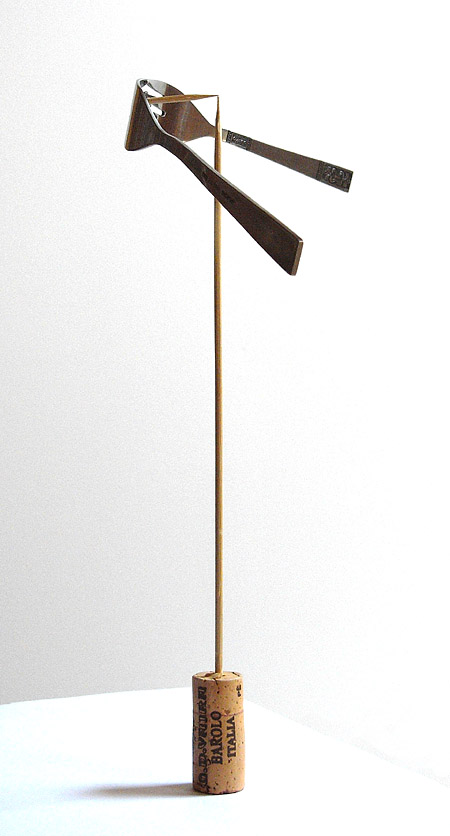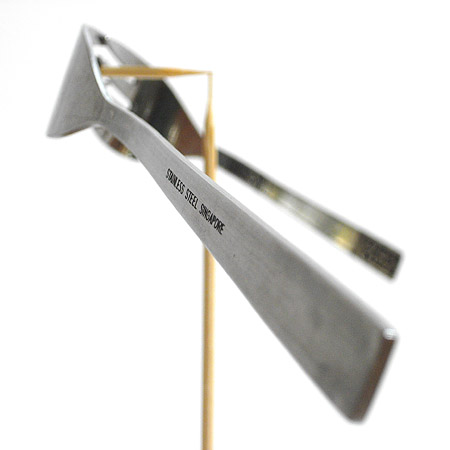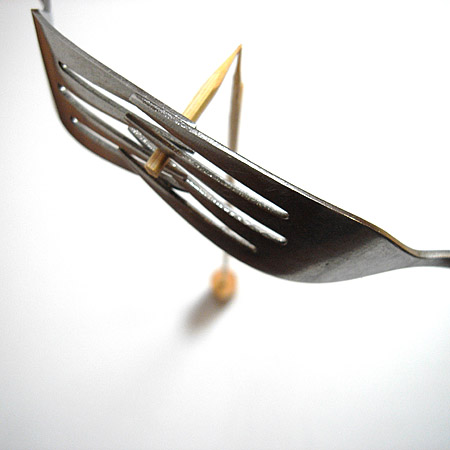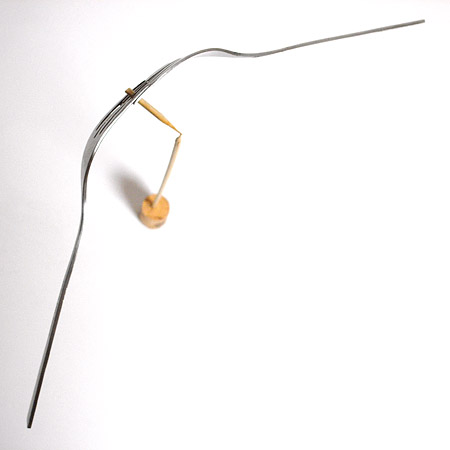
Read about the physics behind the balancing fork trick.
8. Experiment!
Dare to experiment and try new ingredients and procedures. Do control experiments so you can compare results. When evaluating the outcome, be aware that your own opinions will be biased. Have a friend help you perform a blind comparison, or even better a triangle test to evaluate the outcome of your experiments.
In a scientific context, an experiment is a set of actions and observations performed in the context of solving a particular problem, in order to support or falsify a research hypothesis. In a kitchen context, the problem to solve would typically be related to taste, aroma, texture or color. And the required actions and observations would be cooking and eating.
An essential part of the scientific method is that new knowledge is gained when, based previous knowledge, an assumption is made and tested. In the kitchen, this is exactly what you do when you taste your concoctions repeatedly as you cook. And it is also what makes you an experienced cook, because you remember and learn from your previous successes and mistakes. It might sound very complicated, but here’s how it goes:
1) Observation: soup lacks flavor
2) Hypothesis: adding something with flavor might help
3) Experiment: add more spices
4) New observation: soup tastes more (or less)
5) Hypothesis is either supported (or rejected)
Of these steps, I think observation is the easiest. Coming up with a hypothesis however can sometimes be difficult. If you have lumps in your custard or a sauce that’s separating, it isn’t always easy to think of what to do. This is where books on popular food science and molecular gastronomy might help you.

Think outside the cook book! I mentioned in previous post that you should always question authorities and cook books. And even when you have a recipe that works, remember that it’s nothing more than a suggestion. For instance, it can be useful to know when to be sloppy and when to be accurate with measurements. The smaller amount you measure, the greater the precision should be. Let’s consider a hypothetical recipe that calls for 1000 g flour and 1 g of saffron. Whether you use 999 or 1001 g of flour makes no difference, but using 1 or 2 g of saffron will be quite noticable. A good rule of thumb is that you should measure to within +/- 10% of the given amount. But again, don’t follow this blindly. Experience will show when you can be even more sloppy.
Thinking of good experiments to do requires both creativity and experience, and there are many sources of inspiration. The molecular gastronomy movement has come up with a number of books and blogs which point towards new ingredients and procedures. There are several approaches to flavor pairing (i.e. a general one based on experience and a chemical one based on impact odorants). Further more there’s a lot of inspiration to get from regional cooking – also for molecular gastronomists! Lastly, I think considering not only the food but the whole atmosphere and the setting of the meal is important, because our senses are connected!

The best way to judge the outcome of a new procedure or ingredient is to compare it with the original. I’ve previously termed this “parallel cooking”. In scientific contexts it’s very common to do control experiments and I can’t see why this shouldn’t be done in the kitchen routinely. Im convinced that this could have saved us from many kitchen myths!
Once you’ve done your parallel cooking, you have to taste it. If you did the cooking, you’ll probably have an opnion or expectation that the new dish is better or worse than the original. The big problem here is that due to confirmation bias, if you know what you are eating, this will influence your perception of it. Therefore it’s crucial to do a blind tasting (or a double-blind tasting). Have friend help you label each dish with random three digit numbers (to avoid thinking about ranking) and give them to you. If the dishes can easily be recognized due to color, it’s important that the lights are turned down or that you are blindfolded. State which dish you prefer and have your friend reveal the identity of the dishes tasted.
A slightly more sophisticated test is the triangle test which is commonly used in the food industry. The tester is presented with three samples of which two are identical and the task is to pick the odd one out. Using statistics, it’s possible to evaluate the outcome of repeated tests. The number of correct assignments in a number of triangle tests required for you to be 95% sure there is a difference are given in the table below. Read more about simple difference tests here.
| Number of tests performed | Number of correct assignments required |
| 3 | 3 |
| 4 | 4 |
| 5 | 4 |
| 6 | 5 |
| 7 | 5 |
| 8 | 6 |
| 9 | 6 |
| 10 | 7 |
Bionomial distribution for a triangle test (p=1/3) at 0.05 probability level. A more extensive table can be found here.
It seems that this would be the ultimate way to determine whether or not there is a difference between pepsi and coke. It’s more than 50 years since the first experiments were conducted. The theory is simple, but in the real world things aren’t always that simple. Read the entertaining story about Fizzy logic.

There are several examples of experimental cooking out on the net, and I thought I’d share some of them with you as this might illustrate my ideas on the subject.
Many cooks have strong opinions about how garlic should be treated. Should it be minced, crushed or microplaned? And does this really influence the taste and aroma? Or does it only affect the degree of extraction and hence the intensity of the flavor? Dominic of Skillet Doux had a excellent post on this subject in 2006, Deconstructing garlic. The task was formulated as follows:
The subject of this experiment is the effect that various methods of breaking down garlic have on its flavor when used to prepare a dish. The hypothesis is that not only does mincing garlic create a different flavor than crushing it, but also that mincing is the preferred method for pasta sauces. Furthermore, the experiment is intended to determine if microplaning garlic achieves a character different from mincing or crushing.
In his conclusion, Dominic writes ” I was surprised to discover that the difference between the minced and crushed garlic sauces was even more significant than I had previously thought”. Check out his post to find out which kind of garlic treatment he prefers for his pasta sauces. As a side comment it can be mentioned that a group of researchers in 2007 studied the effect of cooking on garlics ability to inhibit aggregation of blood platelets. They found that crushing could reduce the loss of activity upon heating. But unfortunately they didn’t report anything about the flavor.
Other food bloggers have also adopted experimental cooking with emphasis on systematic and thorough testing. Examples include Chad’s experiments with gellan, konjac and iota/kappa carrageenans, Michael Chu’s parallell cooking of bacon and his eggplant test and Papin’s comparison of orange juices – to mention but a few! And I shouldn’t forget Dylan Stiles either whom I mentioned in part 5 of this series:
A challenge with aroma molecules is that they should remain intact during storage and not be released until cooking (or even better, until consumption). A example would be to install a Liebieg condenser over your pot. Dylan Stiles has explored this in his column Bench Monkey by placing a bag of ice on top of the lid. He claims that his roommates preferred the curry which has been cooked under “reflux conditions”. The study was performed in a double blind manner (which I will come back to in part 8 of this series).
An extreme example of the application of the scientific method to cooking appeared in the news last spring when the recipe for the ultimate bacon buttie was revealed by scientists from Leeds University. Commissioned by Danish Bacon, the study evaluated more than 700 variations of a bacon buttie. They even came up with a “formula” for the perfect bacon buttie and quantified the required crispiness and crunchiness. The news story was picked up by many news agencies, so although it wasn’t necessarily ground breaking science, at least it was clever marketing.
*
Check out my previous blogpost for an overview of the 10 tips for practical molecular gastronomy series. The collection of books (favorite, molecular gastronomy, aroma/taste, reference/technique, food chemistry, presentation/photography) and links (webresources, people/chefs/blogs, institutions, articles, audio/video) at khymos.org might also be of interest.

Great article. And also something interesting to comment on,I didn’t know Singapore made stainless steel forks, and I’m from Singapore. haha
[…] zo lekker vinden. En een Westvlaams streekrecept voor konijn. Op Khymos.org viel ik binnen bij tip acht van een reeks van tien rond moleculaire […]
There’s a nice example here of parallell cooking using three different types of paprika to make goulash:
http://aidanbrooks.blogspot.com/2007/05/tale-of-three-goulashes.html
I enjoy your aproach. I returned to culinary school just over a year ago, and was lucky enough to get exposed to molecular gastronomy. I love it!
I don’t want my plates to be a science experimet, but I enjoy dressing up “normal” dish.
Love your,
London